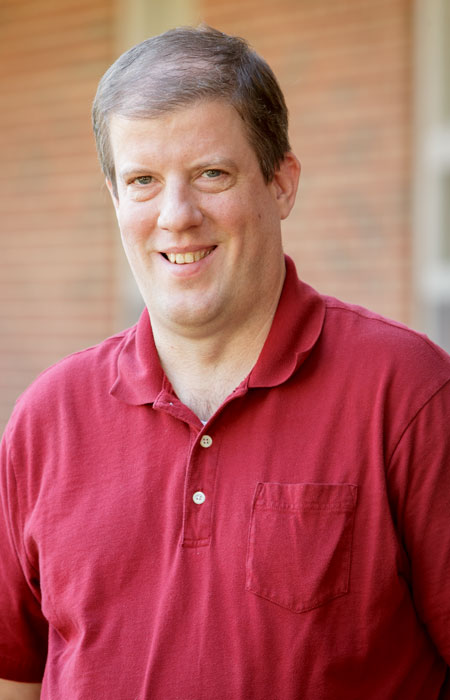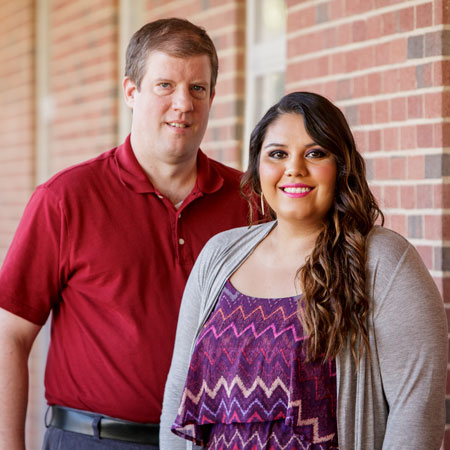The Broader Impact of Scientific Research
Wednesday, March 22, 2017

A few years after arrive at Oklahoma State University in 2004, associate professor of chemistry Charles Weinert began using his own money to develop a summer research program to recruit American Indian students to STEM careers.
“American Indian students are underrepresented in the sciences,” Weinert says. “With nearly 40 tribes in Oklahoma, the opportunity to reach this group of students is higher here than in most places.”
Weinert visited 10 Oklahoma high schools in the spring of 2008 to recruit students for the summer program’s first run. After his visit to Frontier Public Schools in Red Rock, Oklahoma, student Julia “Hope” Conneywerdy emailed Weinert to express her interest in the program.
“She was a little timid when she first came here, but very excited,” Weinert says. “I think she was surprised we let her do most of the work on her own, even letting her use a million-dollar NMR (nuclear magnetic resonance) spectroscopy. It did a lot for her confidence in the lab.”
In the summer of 2008, Weinert was working with a high school student in his lab for the first time and applying for an NSF career grant, which helps junior faculty develop their careers.
He was able to use Conneywerdy’s achievements to demonstrate a successful track record for this proposed program, which strengthened his request.
Weinert adapts the program to each student’s goals and interests. One summer, he even had a third-grader participate, which involved lab demonstrations rather than actual research projects.
However, when the students do take on research projects, they help with components of Weinert’s current research, often completing a stein in the overall puzzle of his investigations of the element germanium.
Conneywerdy and others have helped with integral parts of his research and have been named as contributors on published academic papers.
After Weinert’s NSF career grant expired in 2015, he received a $390,000 three-year renewable NSF research grant. With this grant, he specifically requested funding for the summer research program because he had shown how it fulfilled the grant’s “broader impact on society” requirements.

The NSF funding allowed Weinert to cover such participant costs as housing, transportation and even a stipend. Because this latest grant is renewable, he hopes to continue funding for years to come.
“As long as we continue to be successful and show that people are interested, I’m hoping someday this might turn into an even bigger program,” Weinert says. “In fact, we already have someone verbally committed to coming next summer.”
Researching Silicon Alternatives
Most smartphone or computer chip technologies are made with silicon-based materials. Weinert and his team are busy synthesizing oligomers of germanium, which could lead to more effective chip technology.
“Germanium lies below silicon on the table of elements,” Weinert says. “By studying the structure of germanium and understanding its properties, we hope to synthesize oligogermanes [shorter, finite versions of longer germanium molecular chains] that can surpass the semi-conductivity of related silicon-based materials.”
Weinert’s research with germanium is widely known in the field of synthetic chemistry. As part of a three-day European lecture tour last summer, he was invited to speak at the University of Freiburg in Germany, where Clemens Winkler discovered germa-nium in 1886.
On the fast track
When Conneywerdy was a sophomore at Frontier Public Schools, she had seen pictures of microscopes in science textbooks, but had never used one.
“I always knew I wanted to go into the medical field,” Conneywerdy says. “The summer program was the first time I was in a lab setting, and I finally got to use a microscope. I was hooked!”
After high school, Conneywerdy went to North-western Oklahoma State University on a golf scholar-ship and majored in biochemistry. When she was getting ready to graduate in December 2014, she considered getting her master’s degree while she waited to start physician’s assistant school.
Wanting to return to OSU, she found a fast-track master’s program that was similar to a pre-medical option with OSU’s Department of Microbiology and Molecular Genetics.
Conneywerdy began classes before she was offi-cially accepted and recently completed in her first full semester as an OSU graduate student. She is set to grad-uate with her master’s in May 2016.
“I have to give a big thanks to Dr. Weinert and his summer program,” Conneywerdy says. “It really sparked my interest in science, and I’m so glad to be back at OSU.”
Story by Jamie Hadwin
